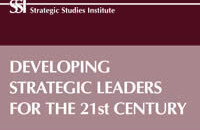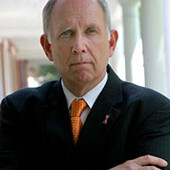This monograph was published in February 2008 by the Strategic Studies Insitute of the U.S. Army War College, and is reproduced here with permission from the author, Carnegie Council Fellow Dr. Jeffrey McCausland.
For a PDF of the complete text (117 pages) scroll to the bottom of the summary. SUMMARY
Future historians will undoubtedly conclude that the terrorist attacks of September 11, 2001 (9/11), were a watershed in American history. The scope and focus of American national security policy changed forever in a few hours. America fought major wars in Afghanistan and Iraq in the aftermath of this historic day. The nation remains engaged in the daunting challenges of post-conflict stability operations and the creation of effective governance in both countries. These efforts will likely continue for many years, and similar challenges may arise. America in the 21st century is more threatened by failing states that are a breeding ground for terrorist movements than by the imminent attack by a hostile peer competitor.
Some important lessons have emerged about this new security environment even as the "war on terrorism" continues both in America and around the globe. First, policymakers must remain engaged with challenges that predate the 2001 terrorist attacks such as globalization, international trade, the spread of AIDS, etc. They must, however, view these problems through a new lens and confront other emerging challenges. Furthermore, this condition is not temporary. The nation must expect that the threat of multiple crises will continue indefinitely. Finally, the challenge of international terrorism cannot be effectively confronted solely by the use of military force. It is fundamentally important that American national security strategy emphasizes the effective integration of all elements of national power—political, diplomatic, and economic, as well as military.
These events of the first decade of the 21st century have changed how Americans must think about "national security." They have dramatically expanded not only the number and scope of issues, but also the overall complexity of the process. Americans who felt safe at home and viewed security threats as distant from our shores no longer feel this way. Consequently, the requirement for interagency decision making has accelerated, demands for greater policy flexibility have increased, and a process that was largely confined to a few agencies of the Federal Government now involves a multitude of new players and allied states. Clearly, the sad and apparently unexpected aftermath of the Iraq War underscores the critical need for significant changes in the planning of military operations, preparation for post-conflict requirements, and oversight of their execution.
As the nation embarked on this new era, the 2002 National Security Strategy noted that we must "transform America's national security institutions to meet the challenges and opportunities of the 21st century." The Bush administration responded initially with the creation of the Department of Homeland Security, representing the largest change in the structure of the Federal Government since the National Security Act of 1947. But we must also transform existing institutions, the policy process, and how we "think" about the defense of the nation. Furthermore, as General Richard Myers, former Chairman of the Joint Chiefs of Staff, observed, this transformation cannot wait—"it must take place as we wage the war on terrorism."
Yogi Berra was once asked by a sportswriter while he was serving as the manager of the New York Yankees what was the most important thing in developing a world championship team. Berra replied instantly, "Hire world championship players." While this is true in sports and private enterprise, it is equally important in government. If America is to meet the multiple challenges of the 21st century, it is crucial that we develop a system that places the right people in the right places in government at the right moment. The nation critically needs civilian policymakers who can manage change and deal with the here and now. This monograph examines the development of career civilian leaders for strategic decision making in the national security policy process. Such development must include the recruitment of quality personnel, experiential learning through a series of positions of increasing responsibility, training for specific tasks or missions, and continuous education that considers both policy and process. Consequently, it requires people who are not only substantively qualified and knowledgeable regarding policy issues but also possess the leadership abilities to direct large complex organizations.
This analysis considers existing efforts in the Office of the Secretary of Defense (OSD), State Department, and Central Intelligence Agency (CIA) and provides appropriate recommendations for each. It also outlines the changes required to existing personnel management systems and development programs to create an effective cadre of civilian national security professionals for the policy process. Clearly, these recommendations may be applicable for other executive agencies as well. These three departments were selected because they have traditionally had the primary (if not exclusive) role in the development of foreign and defense policy. There are also obviously growing requirements for those with technical expertise, human resource management, finance/comptroller skills, et cetera. The development of personnel with these talents for these three agencies is not the subject of this monograph.
Certain assumptions are crucial to this analysis. First, it is critical to understand that the words "training" and "education" are different when considering human capital development. Training is concerned with teaching what to think and what the answers ought to be. Education is focused on teaching how to think and what the questions ought to be. Training is most frequently used when the goal is to prepare an individual or an organization to execute specified tasks. It often includes task repetition, not unlike an athletic team learning to execute plays, and normally is the preferred method of learning when the goal is to perform operations in which success, failure, and completion can be clearly measured. Education has more to do with how to think about problems and how to deal with challenges that may not lend themselves to outright solutions. It is a matter of intellect, thought, indirect leadership, advice, and consensus building.
Second, we must also differentiate between "leadership" and "management." Management is about coping with complexity. It is a response to a significant development of the 20th century, namely the emergence of large, complex organizations. Good management brings order to what would otherwise be chaos. Leadership, by contrast, is about coping with change. Management remains important for the day-to-day success of any organization and focuses on such issues as planning/budgeting, organizing/staffing, and controlling/problem solving. By contrast, leadership begins with setting direction and aligning people, as well as motivating them to success. The successful development of government policy for the war on terrorism wholly depends upon developing leaders of substance at all levels of executive agencies. They must be able to balance the pressing requirements of management with the critical need to provide their organizations, and the collective effort, leadership.
Problems with the recruitment, retention, and development of individuals for the national security process are not new. The last 20 years are replete with studies led by leading American policymakers or think tanks, U.S. Government Accounting Office Reports, congressionally directed studies, and even presidential directives. They have focused on a single government agency, the interagency process, or government service in general. These studies demonstrate that problems associated with the recruiting, retention, and development of the "best and the brightest" for a career as a civilian in the national security process are not new. Furthermore, they demonstrate that this problem has taken on increased saliency in the last decade and in particular in the aftermath of the attacks of 9/11. It is also interesting to note that many of their recommendations are remarkably similar. Many stress the growing need for greater developmental opportunities, lateral entry, required rotational assignments to other agencies, etc. Finally, this litany of reports is a sad testimony to the Federal Government's inability to adequately confront this issue despite its growing importance.
Still, some critics will argue that the nation is at war and can ill-afford reorganizations or changes at this critical moment. The sad tragedy that has been the Iraq War would suggest otherwise. It became clear almost immediately following the invasion in 2003 that fundamental errors had been made in intelligence and policy analysis. From the very onset, the United States not only required additional troops for the occupation of Iraq, but also enhanced civilian leadership and capacity to reconstruct Iraqi society. Without both these components, efforts to forestall the ensuing chaos, as well as the resultant insurgency, were doomed to failure. The historical record since 2001 is replete with studies and analyses that clearly show the pressing need for a better synergy of efforts by the various agencies of the Federal Government to confront challenges of establishing effective regimes in both Baghdad and Kabul.
As American patience wears thin over the failure to achieve clear success in both Iraq and Afghanistan, the argument might be presented that this has been a tragic aberration. Once the United States withdraws, it can avoid future efforts to rebuild societies torn apart by conflict. Unfortunately, this global conflict will not allow us that luxury. We are confronted by an enemy who would replace secular governments with theocratic regimes hostile to our national interests and values. Their strategy amounts to "a global series of insurgencies, competing for the right to govern" in many predominantly Muslim nations around the globe. State collapse will continue to challenge the national interests of the United States and its allies for decades to come. If we are to prevail, we must mobilize and synchronize all elements of our national power—diplomatic, military, economic, social, and informational-to confront these new and extremely dangerous adversaries. The key actions required in a counterinsurgency involve "work we associate with civilian skill sets and even agencies—but the uniformed military is often placed in the position of having to undertake such activities." Consequently, a rebalancing of roles between military and civilian leaders is required. Regardless of what the final outcome is in Iraq, it may not be our past so much as our future. This new security environment requires better qualified career civilian leaders to think in different patterns in order to accomplish these daunting tasks.




